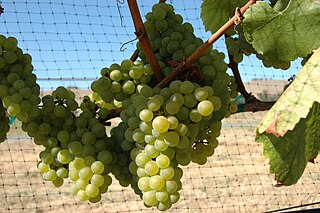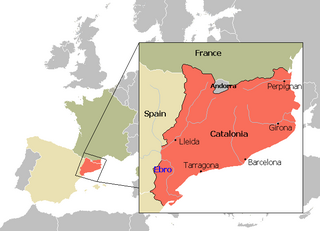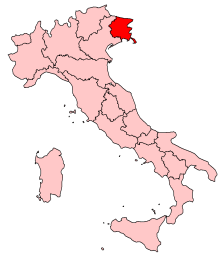
Chardonnay is a green-skinned grape variety used in the production of white wine. The variety originated in the Burgundy wine region of eastern France, but is now grown wherever wine is produced, from England to New Zealand. For new and developing wine regions, growing Chardonnay is seen as a 'rite of passage' and an easy entry into the international wine market.

Cabernet Sauvignon is one of the world's most widely recognized red wine grape varieties. It is grown in nearly every major wine producing country among a diverse spectrum of climates from Australia and British Columbia, Canada to Lebanon's Beqaa Valley. Cabernet Sauvignon became internationally recognized through its prominence in Bordeaux wines, where it is often blended with Merlot and Cabernet Franc. From France and Spain, the grape spread across Europe and to the New World where it found new homes in places like California's Napa Valley, New Zealand's Hawke's Bay, South Africa's Stellenbosch region, Australia's Margaret River, McLaren Vale and Coonawarra regions, and Chile's Maipo Valley and Colchagua. For most of the 20th century, it was the world's most widely planted premium red-wine grape until it was surpassed by Merlot in the 1990s. However, by 2015, Cabernet Sauvignon had once again become the most widely planted wine grape, with a total of 341,000 hectares (3,410 km2) under vine worldwide.

Argentina is the fifth largest producer of wine in the world. Argentine wine, as with some aspects of Argentine cuisine, has its roots in colonial Spain, as well in the subsequent large Spanish and Italian immigration which installed its mass consumption. During the Spanish colonization of the Americas, vine cuttings were brought to Santiago del Estero in 1557, and the cultivation of the grape and wine production stretched first to neighboring regions, and then to other parts of the country.

New Zealand wine is produced in several of its distinct winegrowing regions. As an island country in the South Pacific Ocean, New Zealand has a largely maritime climate, although its elongated geography produces considerable regional variation from north to south. Like many other New World wines, New Zealand wine is usually produced and labelled as single varietal wines, or if blended, winemakers list the varietal components on the label. New Zealand is best known for its Marlborough Sauvignon Blanc, and more recently its dense, concentrated Pinot Noir from Marlborough, Martinborough and Central Otago.

Brown Brothers Milawa Vineyard is a family-owned wine company based in Milawa, Victoria, Australia. Brown Brothers was founded in 1889 by John Francis Brown and continues to be owned and operated by his descendants on the original property. Brown Brothers makes wine from a wide range of grape varieties and into a range of styles.

Washington wine is a wine produced from grape varieties grown in the U.S. state of Washington. Washington ranks second in the United States in the production of wine. By 2017, the state had over 55,000 acres (220 km2) of vineyards, a harvest of 229,000 short tons (208,000 t) of grapes, and exports going to over 40 countries around the world from the 940+ wineries located in the state. While there are some viticultural activities in the cooler, wetter western half of the state, the majority (99.9%) of wine grape production takes place in the shrub-steppe eastern half. The rain shadow of the Cascade Range leaves the Columbia River Basin with around 8 inches (200 mm) of annual rain fall, making irrigation and water rights of paramount interest to the Washington wine industry. Viticulture in the state is also influenced by long sunlight hours and consistent temperatures.
The state of Oregon in the United States has established an international reputation for its production of wine, ranking fourth in the country behind California, Washington, and New York. Oregon has several different growing regions within the state's borders that are well-suited to the cultivation of grapes; additional regions straddle the border between Oregon and the states of Washington and Idaho. Wine making dates back to pioneer times in the 1840s, with commercial production beginning in the 1960s.

Walla Walla Valley is an American Viticultural Area (AVA) located within Washington state and extending partly into the northeastern corner of Oregon. The wine region is entirely included within the larger Columbia Valley AVA. In addition to grapes, the area produces sweet onions, wheat and strawberries After the Yakima Valley AVA, the Walla Walla AVA has the second highest concentration of vineyards and wineries in Washington State. Walla Walla hosts about 140 wineries. The area was recognized on March 7, 1984 by the Bureau of Alcohol, Tobacco and Firearms (ATF), Treasury after reviewing the petition submitted by Mr. Richard L Small, President of the Walla Walla Valley Winegrowers Association, for the establishment of a viticultural area in southeast Washington and northeast Oregon, east of Lake Wallula, to be known as "Walls Walls Valley." At the time, Walla Walla Valley viticultural area was approximately 178,560 acres (279 sq mi) with two bonded wineries and about 60 acres (24 ha) from several vineyards.

Catalan wines are those that are produced in the wine regions of Catalonia. Occasionally, the appellation is applied to some French wine made in the Catalan region of Roussillon and neighboring areas, also known as Northern Catalonia or the Pays catalans. The city of Barcelona is the capital of Catalonia and despite not being in a wine region, it is the focal point of the Catalan wine industry: a primary consumer market, its port provides export functions and a source of financial resources and investment. The Penedès is the largest wine-making region in Catalonia.

California wine production has a rich viticulture history since 1680 when Spanish Jesuit missionaries planted Vitis vinifera vines native to the Mediterranean region in their established missions to produce wine for religious services. In the 1770s, Spanish missionaries continued the practice under the direction of the Father Junípero Serra who planted California's first vineyard at Mission San Juan Capistrano.

Victorian wine is wine made in the Australian state of Victoria. With over 600 wineries, Victoria has more wine producers than any other Australian wine-producing state but ranks third in overall wine production due to the lack of a mass bulk wine-producing area like South Australia's Riverland and New South Wales's Riverina. Viticulture has existed in Victoria since the 19th century and experienced a high point in the 1890s when the region produced more than half of all wine produced in Australia. The phylloxera epidemic that soon followed took a hard toll on the Victoria wine industry which did not fully recover till the 1950s.

Friuli-Venezia Giulia wine is wine made in the northeastern Italian region of Friuli-Venezia Giulia. There are 11 denominazione di origine controllata (DOC) and 3 denominazione di origine controllata e garantita (DOCG) in the Friuli-Venezia Giulia area. The region has 3 indicazione geografica tipica (IGT) designations Alto Livenza, delle Venezie and Venezia Giulia. Nearly 62% of the wine produced in the region falls under a DOC designation. The area is known predominantly for its white wines, which are considered some of the best examples of Italian wine in that style. Along with the Veneto and Trentino-Alto Adige, the Friuli-Venezia Giulia forms the Tre Venezie wine region, which ranks with Tuscany and Piedmont as Italy's world class wine regions.

Gaja is an Italian wine producer from the Piemonte region in the district of Langhe, chiefly producing a number of Barbaresco and Barolo wines, and later diversified into Brunello di Montalcino and "Super Tuscan" production. Its current owner and president Angelo Gaja is credited with developing techniques that have revolutionised winemaking in Italy, and terms such as "the undisputed king of Barbaresco", and "the man who dragged Piedmont into the modern world" have been applied to him, and whose Barbaresco wine is considered a status symbol on a par with Château Lafite Rothschild or Champagne Krug.
Foris Vineyards Winery is an American winery located near Cave Junction, Oregon in the Illinois Valley region of the Rogue Valley AVA of Southern Oregon. As one of Oregon's pioneering grape growers, Ted Gerber planted his first vineyard in 1974. For 15 years, Gerber provided fruit to other winemakers, until 1986 when the winery was founded by Ted and Meri Gerber and the Foris label was launched.

Reif Estate Winery is located in Niagara-on-the-Lake in Ontario, Canada. Reif Estate is primarily known for playing an important in role pioneering the Ontario wine Industry, as well as planting some of the first Vitis vinifera vines in the Niagara region.

Dutch wine is wine made in the Netherlands. Although a small producer of wine, it is nowadays a strong growing branch of Dutch agriculture. Currently, the country has 180 commercial vineyards.
Cono Sur Vineyards & Winery is a subsidiary of Concha y Toro Winery and is the third largest exporter of bottled wine in Chile. Established in 1993, its name is a reference to its location in the Southern Cone of South America and a play on the word connoisseur. In 2015, it was the official wine of the Tour de France.

Red Willow Vineyard is a grape-growing estate located in the far western end of Yakima Valley AVA, within the Yakama Indian Reservation. Beginning with their relationship with Columbia Winery and Master of Wine David Lake, grapes from Red Willow have been used to produce some of the most critically acclaimed Washington wines with the vineyard's name regularly being featured on vineyard designated wines. Paul Gregutt, wine writer for the Seattle Times and Wine Enthusiast, list Red Willow as one of the "top ten" vineyards in the entire state.

Hawk Haven Vineyard & Winery is a winery in Rio Grande section of Lower Township in Cape May County, New Jersey. A family dairy and produce farm since 1940, the vineyard was first planted in 1997, beginning with Cabernet Sauvignon. The winery opened their doors to the public in 2009 with their first vintage in 2007, which consisted of the American Kestrel White, Red Table Wine, Merlot, and Cabernet Sauvignon. Today, Hawk Haven has 16 acres of grapes under cultivation, and produces 5,000 cases of wine per year. The winery is named for the large number of hawks that migrate to the farm every year. They currently have sixteen different varietals and all of the grapes are harvested, pressed, fermented, aged, blended, and bottled on site.

Sylvin Farms Winery is a winery in the Germania section of Galloway Township in Atlantic County, New Jersey. The vineyard was first planted in 1977, and opened to the public in 1985. Sylvin Farms has 11 acres of grapes under cultivation, and produces 1,000 cases of wine per year. The winery’s name is an amalgamation of Sylvia and sylvan, reflecting the owner's wife's name and the surrounding Pine Barrens, respectively.




















